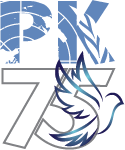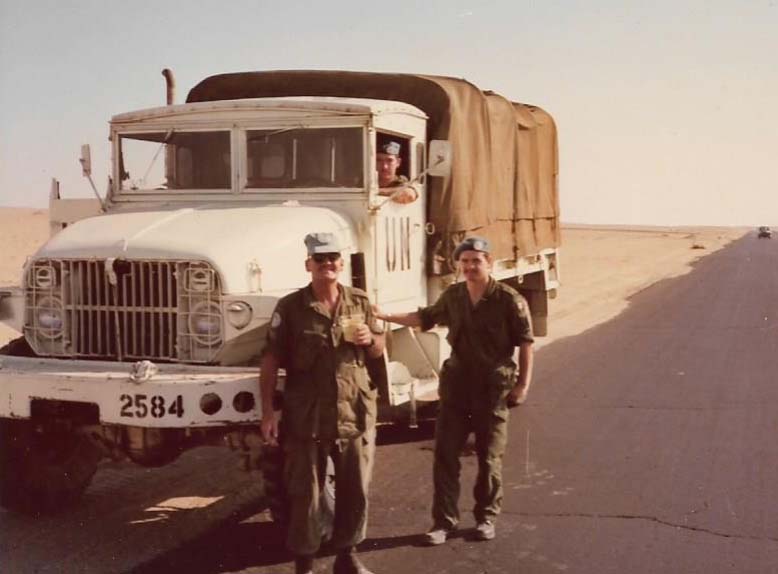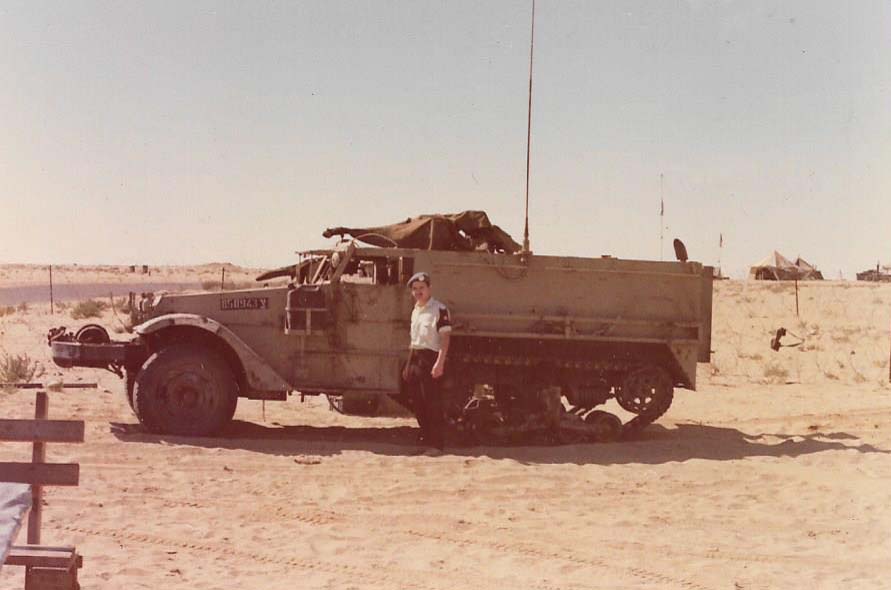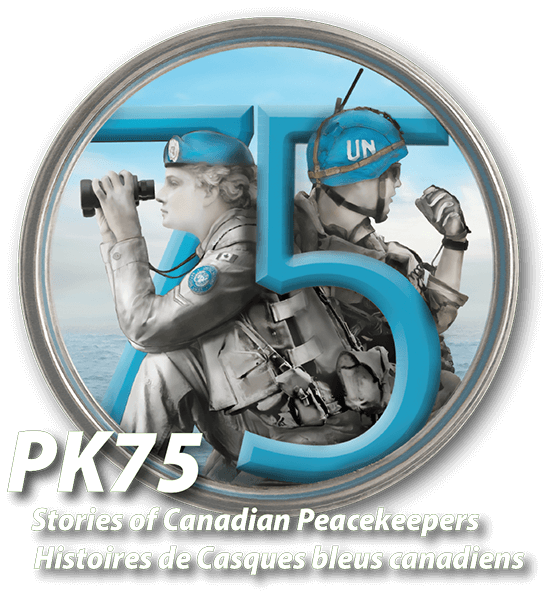

North Vancouver, BC, Canada
Bruce Docherty
Current Location: Surrey, BC, Canada
The anti-aircraft nests surrounding the Airport in Cairo told us that we were really there. After a long, hot day, my coworkers and I went to Junior Ranks Mess to relax over a couple of beer. Out of the blue, some guy I had never met before started berating me, he had found out that I was a Reservist. I started pushing my chair back, when I felt a hand on each shoulder pushing me back down into my chair, hearing, “Sit down Bruce, we’ve got this”. With that, the entire table stood up. That is the first of many moments I vividly recall from my tour in Egypt.
As a certified driver of the 2½ ton Troop Transport trucks (Deuce and a half), I drove to Cairo every second week to pick up rations from our supply base. I regularly saw the American helicopters taking off for patrols of the Suez Canal, and asked if I could catch a ride as a tourist. “I’d really like to help you, but…with the required authorizations, protocols, paperwork and red tape, my hands are tied”. The very next day, this same U.S. Officer requested coffee, tea, cream, sugar, cookies etc., for his crews. My Sgt said that he would have to “Speak to Corporal Docherty.” So, even though I had previously received instructions to assist the American crews whenever possible, when the Officer made his request, I replied, “I’d really like to help you Sir but…with the required authorizations, protocols, paperwork and red tape, my hands are tied as to who I am authorized to issue rations to.”
We were allowed to purchase two open beer, and borrow a chair from the mess, to watch the movies. I eventually finished my first beer, reached down to pick up the second, took a mouthful, an immediately spit it out, to a chorus of “Pinky”. The area was infested with ants, and if a beer was left uncovered, the ants would go for a swim. I very quickly joined the chorus of “Pinky”.
I was the only Canadian Diver to participate in clearance operations of the Suez Canal during my tour of duty. I was in the Dive Chief’s quarters discussing diving with his team, when someone burst into the room, and was just as quickly removed. It turns out the American Divers had just completed their assigned Canal sweeps for the day and this diver was excited to show his Diving Chief what he had recovered. The Chief let out the divers universal all clear, “It’s ok, he’s a Diver” after which the Diver was right back in to display his trophy. He had recovered a Russian AK-47 in mint condition. My big find the next day was a capstan that had been blown off one of scuttled ships.
When we left for Israel, we all had our cameras out when we saw a “destroyed tank”, by the roadside, but we then also noticed that the turret was following us. The Israeli Officer in charge of the outpost told us that we could take as many pictures as we wanted, but must point our cameras toward the UN buffer zone and Egypt. I found a fully operational Israeli Halftrack and set up the camera for the shot.
It was common to see meteors in the night, but on one occasion it just seemed to hang there, and soon after it disappearing there was a burst of light. Soon there were lights in the night sky, traveling in both directions. I would never say we were afraid, but I knew the closest, and safest place for cover within ten feet of anywhere I went.
A group of volunteers was building an FM radio station, and I started to help out. We all wrote to our local area radio stations, asking for records. I was asked to pick some music I liked, the station manager said “Good, these are for your show. When the Polish heard that we were going to transmit live, all FM capable radios were confiscated. After listening to the station for a week, they brought in FM radios, and distributed them to their troops. The Poles were amazed that we were able to find so many Officers that were available to be our radio announcers. They were even more amazed to find out that we were Privates and Corporals.
After my UN leave ran out, I returned to working at the Fleet Diving Unit. The Coxswain, Chief (Red) Larson, ordered me to cut off my handlebar moustache. I replied that it was legal and conformed to current regulations. Red scowled and walked off. After checking on one of the trainee divers, Red came back and greeted me as I surfaced from a dive with my handlebar moustache now dripping, saying, “It’s not legal now, Cut It Off!”.
Biography
Bruce qualified as a Navy Diver in 1972 working extensively at the Fleet Diving Unit (Pacific) (FDU(P)), sailing on the HMCS Fraser as a member of her Diving Team, and on HMCS Qu’Appelle as her senior Diver. While in Panama City aboard the HMCS Qu’Appelle, Bruce, as senior Diver, supervised the recovery and attempts to revive a drowning victim, a member of his own ships company.
Bruce was deployed overseas in 1974 to serve with the Second United Nations Emergency Force (UNEF II) in Egypt, returning home in 1975. While in Egypt, he was the only Canadian Diver to participate in clearance operations of the Suez Canal with the United Nations in Egypt 1974–1975. He returned to Canada to study at Capilano College in North Vancouver in the fall of 1975, and upon completion of two semesters, he was once again returned to active service, diving at FDU(P). In the fall of 1977, Bruce was accepted to Study Marine Engineering at the Canadian Coast Guard College in Sydney, NS, as an Officer Cadet. After two years of study, he joined the Heavy Ice Breaker, the Canadian Coast Guard Ship (CCGS) John A McDonald as a Junior Engineer, patrolling and sailing through the Northwest Passage.
In January of 1980, Bruce returned to the West Coast, once again sailing on HMCS Port De La Rein (PDLR) as a Petty Officer of the watch and senior Diver. He left the PDLR on the 1st of April to join the CCGS Quadra, a Weather Ship stationed at “Ocean Station Papa” about 950 miles off the BC Coast.
While working as a Marine Engineering Officer aboard some of the smaller Department of Fisheries and Oceans (DFO) patrol vessels Bruce recognized a real need for qualified First Aid Attendants, so he obtained certification as one. He then volunteered to serve as the only First Aid Attendant on numerous Department of Fisheries and Oceans/Coast Guard vessels over the next 30 plus years and was frequently the only First Aid Attendant aboard. These First Aid duties were in addition to his paid duties as an Engineering Officer, but at no time during his years as a qualified First Aid Attendant, did he receive any additional pay to hold the qualification, or for the responsibility that went with it.
While working full time on the Department of Fisheries/Coast Guard Ships for 35 years Bruce continued to serve with the Naval Reserves using almost all his holiday time and saved overtime to train and serve with the Navy, accumulating well over twelve years of active Naval service. In 1993, he lead a ten member diving team, comprising members selected from Naval Reserve Diving teams from across Canada, on a foreign deployment to Porto Rico.
After successfully reviving a near fatal drowning patient, Bruce joined the Surrey St. John Ambulance Division in the fall of 1993 to improve his abilities and attempt to maintain a standard with which he was satisfied. After the unexpected passing of one of the Officers of Surrey’s St John Ambulance Cadet Division, Bruce was asked to help out. He did so for several years as an Officer in the Adult Division, eventually transferring to the Cadet Division as their Administration Officer, a position he held for eight years. For six years he served the Divisional Superintendent for the Surrey St. John Ambulance Cadet Division 336C, the maximum amount of time allowed. Bruce also completed 30+ Years of Voluntary First Aid Community Service with St John Ambulance Brigade from 1993 to present.
In May of 2011, Bruce retired as a Lieutenant-Commander from the Canadian Coast Guard (CCG), having served his last ten years as Chief Engineer on the Search and Rescue Cutter CCGC Point Henry. During his service with the Coast Guard, in recognition for his service, he received the Coast Guards Exemplary Service Medal and, several years, later received a Bar to the medal for continuing service.
Bruce joined the Canadian Lifeboat Institute (CLI) in 2011 as a Marine Engineer and primary First Aid Attendant, serving aboard their two all volunteer Search and Rescue Lifeboats, 2011 to present. With his retirement from the Royal Canadian Naval Reserves (RCNR) he was presented with the Beaver Medal recognizing his service to the marine community on the Pacific coast. Bruce is currently working as a part time, senior watchkeeping Engineer aboard the BC ferries Queen of Coquitlam, a 456 foot “C” class ferry.

UN ration run.

The Israeli Officer in charge of the outpost told us that we could take as many pictures as we wanted, but only toward the UN buffer zone and Egypt. I found a fully operational Israeli Halftrack, so I set up the camera for the shot.


